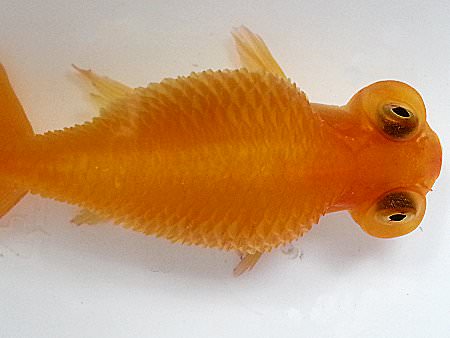| Back to Back Issues Page |
 |
|
The Goldfish Gazette, Issue #052 -- Unexplained Illnesses April 28, 2018 |
Goldfish Care TipsA Free Monthly Resource For Goldfish Enthusiasts In This Issue
Goldfish don't get sick if they are receiving the proper care, but sometimes it isn't the care they are receiving that causes the problem. Unexplained Illnesses I often receive emails from concerned Goldfish owners about their sick fish. What Has Changed Recently?If the illness isn't immediately obvious, I ask what has changed recently? The reason I ask this is because diseases can be brought into the aquarium or pond from a variety of external sources. Examples are:
What is different?Sometimes nothing has changed recently but your fish are sick.This was the case with an aquarium full of my juvenile Water Bubble Eyes from last season's spawns. They were developing strange sores that lifted scales and body lumps. I initially put this down to a weakness of the strain, as they had been difficult to spawn, and the males developed few if any breeding tubercles. After a few months of this, one developed dropsy. Again I thought this may be due to a weak strain. After a second fish developed dropsy, I started to think that this particular aquarium had a problem, as none of my other juveniles in ponds had any illnesses. I asked the question, what is different? I went through a list of factors and compared the two groups of fish:
So what was I doing differently with these fish? I had a thought. The only thing I was doing differently was adding an anti-algal chemical to the water at each water change. Surly not! This was a chemical produced by a large respected company for the control of algae. I looked up the product on Google to see if there was any negative reviews of the product. I found plenty. Many people lost their fish within hours. These were mainly tropical fish. I also found an article written by a chemist who provided information on the effects this product has on other freshwater species, and it wasn't good. At the recommended dosage for aquariums of 1.18 ppm (parts per million), this amount would kill bluegill and trout within 48 hours. There has been no testing done specifically on Goldfish, but I suspect from the data I have collected, it is a product to be avoided. I have lost 5 of the 10 fish so far, and another is looking lethargic. This despite multiple water changes, and not using the product for some weeks. The internal organ damage is obviously severe and long term. Being able to compare two sets of identical juveniles was a big advantage. If you only have one community of fish, you can still isolate the different elements that make up your fish's environment and make changes or do testing to isolate what is making your fish sick. Read more about this product on the Goldfish Dangers page under Green Water by clicking here…
Comments? Ideas? Feedback? I'd love to hear from you. Just reply to this e-zine and tell me what you think, or what topics you want covered. Next Month's Topic Hand Feedingwww.facebook.com/aboutgoldfish |
| Back to Back Issues Page |